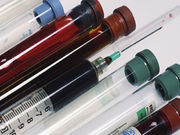Still in development, but doctors’ office screening method could curb overprescribing
THURSDAY, Jan. 21, 2016 (HealthDay News) — Researchers say they’re closer to developing a blood test that distinguishes between viral and bacterial respiratory infections. The findings are published in the Jan. 20 issue of Science Translational Medicine.
Ephraim Tsalik, M.D., Ph.D., assistant professor of medicine at the Duke University School of Medicine in Durham, N.C., and colleagues developed a test to distinguish viruses from bacterial infections by analyzing host gene expression patterns. The team conducted trials of the test on 273 patients with respiratory infections and 44 healthy individuals.
The researchers found that, overall, the test was accurate 87 percent of the time in distinguishing between bacterial and viral infections, and noninfectious cause of illness. In comparison, the accuracy rate for procalcitonin was 78 percent, and for three published classifiers of bacterial versus viral infection, 78 to 83 percent.
“Even with that imperfect test, other studies showed that using it can reduce antibiotic use by about 40 to 50 percent compared to no testing at all,” Tsalik told HealthDay. The new test works by detecting how genes “turn off and on in a particular pattern” in response to bacteria, a virus, or another cause, he said. Tsalik added that it’s unique because of its speed and simplicity. There are no details yet about price, but he said researchers want to make it affordable.
Several authors disclosed financial ties to the pharmaceutical and biotechnology industries; several authors disclosed patents related to the study material.
Full Text (subscription or payment may be required)
Copyright © 2016 HealthDay. All rights reserved.








